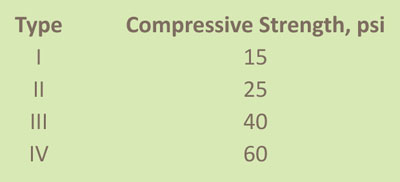Exploring Insulation Materials
Polyurethane
Polyurethane
insulation, commonly called PUR, is a closed-cell foam insulation material. It
is typically either spray applied or poured in place. Spray Applied
Polyurethane Foam (SPF) requires specialized equipment to apply the material
and proper technical training to get the best results. SPF is used in a wide
variety of applications, including industrial applications such as pipes,
tanks, cold storage facilities, freezers, and walk-in coolers.
ASTM
C 1029 Standard Specification for Spray-Applied Rigid Cellular Polyurethane
Thermal Insulation covers the types and physical properties for using thermal
insulation between -22°F and 225°F. The standard classifies materials into four
types by compressive strength, as follows in the chart below.

The
standard covers requirements for thermal resistance of 1.0 inch thickness,
compressive strength, water vapor permeability, water absorption, tensile
strength, response to thermal and humid aging, and closed-cell
content. For comparison purposes, the maximum thermal conductivity for all
types is 0.16 Btu-in/(h ft²°F).
ASTM
C 945 Standard Practice for Design Considerations and Spray Application of a Rigid
Cellular Polyurethane Insulation System on Outdoor Service Vessels covers
substrate preparation, priming, selection of the polyurethane system, and
selection of the protective covering for outdoor service. The Spray
Polyurethane Foam Alliance (www.sprayfoam.org) is a trade organization
of SPF producers and contractors who can provide additional assistance on SPF.
Polyurethane
foam is also available as one- or two-component poured-in-place systems in
disposable containers.

